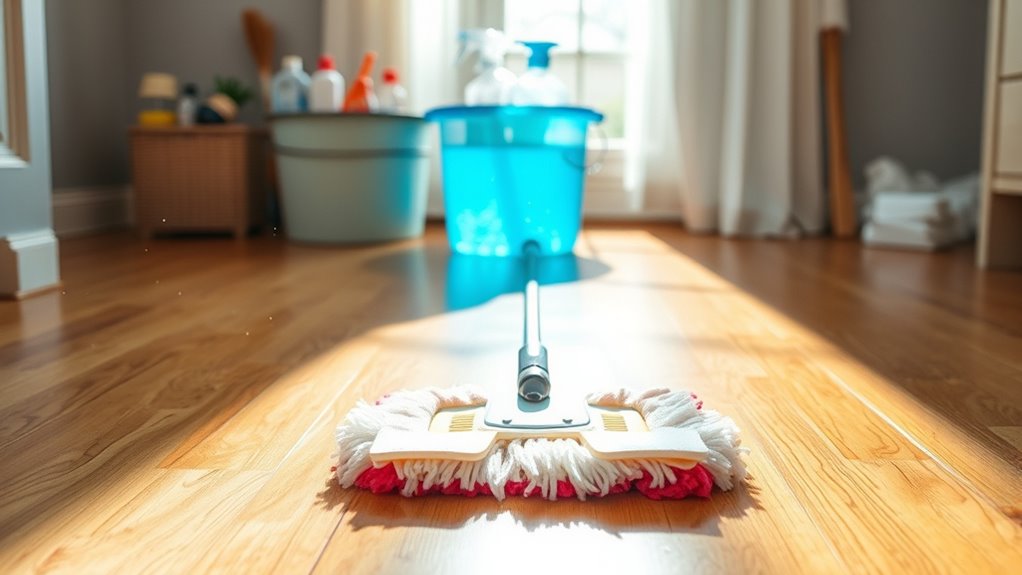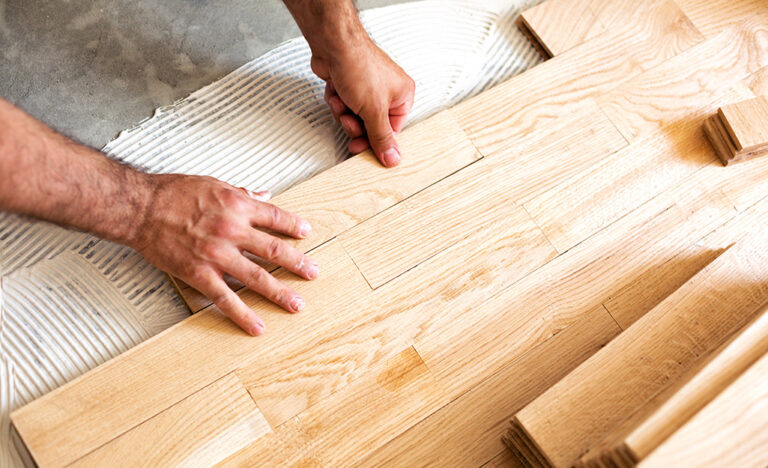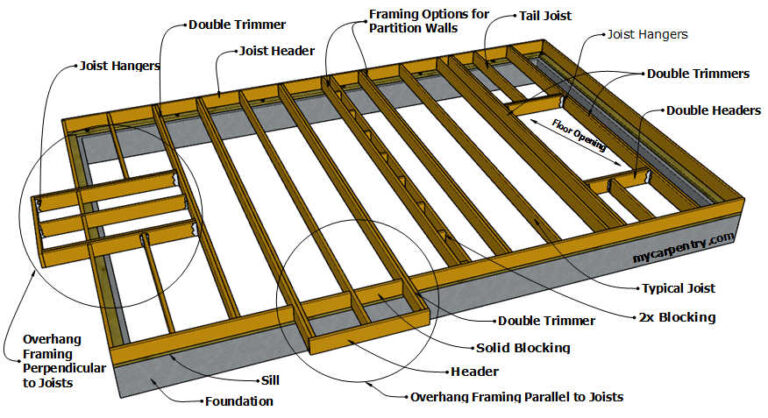To deep clean your floors, first clear furniture and debris to access all areas. Use tools suited to your floor type—like a microfiber mop for hardwood or a steam mop for tile. Apply gentle, pH-neutral cleaners sparingly to avoid damage, especially on wood and grout. Scrub grout lines with a stiff brush and dry promptly to prevent warping. Regular maintenance and proper mat placement will protect your floors longer. Learn specific techniques to keep each pavimento type pristine and durable.
Preparing Your Floors for Deep Cleaning
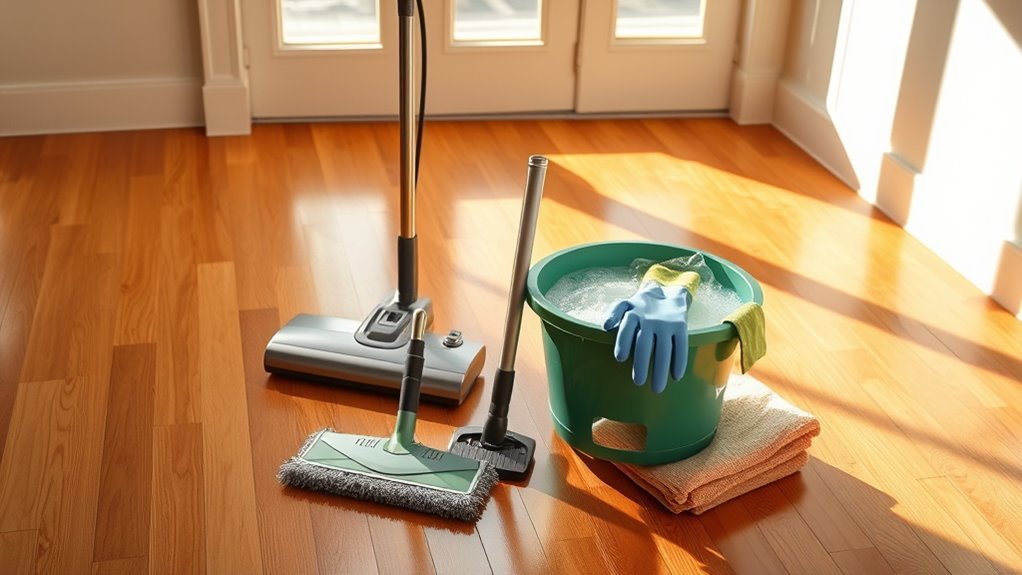
Before you plunge into deep cleaning your floors, it’s essential to prepare the area thoroughly to guarantee the process is effective and efficient. Start with meticulous floor preparation by clearing the space of furniture and rugs, giving yourself full access. Next, perform a detailed surface inspection, scanning for cracks, stains, or areas with accumulated debris. This step guarantees you target problem zones appropriately and avoid damage during cleaning. Pay close attention to corners and edges where dirt often hides. If you spot any loose floorboards or peeling finishes, address these before proceeding. Proper floor preparation and surface inspection not only enhance cleaning results but also protect your floors, empowering you to maintain a pristine environment with confidence and freedom.
Tools and Supplies Needed for Different Floor Types
Although each floor type demands specific care, having the right tools and supplies tailored to your flooring material is crucial for effective deep cleaning. Choosing the proper mop types and floor vacuums can make your task more efficient and protect your floors from damage.
- Pavimenti in legno duro: Use a microfiber mop with a gentle cleaning solution and a floor vacuum with soft bristles to avoid scratching.
- Tile Floors: Opt for a steam mop or sponge mop paired with a vacuum that handles debris well.
- Pavimenti in laminato: Select a flat mop and a lightweight, suction-only floor vacuum to prevent water damage.
- Vinyl Floors: Use a damp mop and a versatile floor vacuum with adjustable settings for ideal care.
Matching tools to floor types guarantees you clean thoroughly without compromising your flooring’s integrity.
Deep Cleaning Hardwood Floors Safely
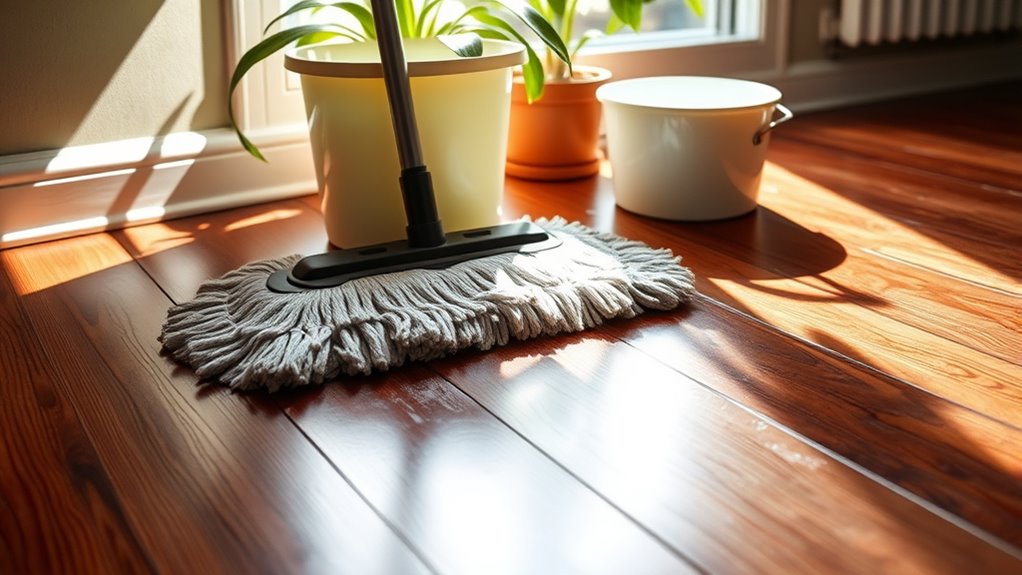
When deep cleaning hardwood floors, you need to select gentle, pH-neutral cleaners specifically designed for wood to avoid damaging the finish. Using too much water can warp or stain the wood, so apply moisture sparingly with a damp mop or cloth. Following these precise techniques guarantees your floors stay clean without compromising their integrity.
Choosing Gentle Cleaners
Since hardwood floors are sensitive to harsh chemicals and excessive moisture, choosing gentle cleaners is critical to protect their finish and longevity. You want to maintain your floors’ beauty without compromising their integrity. Consider these key points when selecting a cleaner:
- Opt for natural alternatives like diluted vinegar or castile soap; they effectively clean without damaging finishes.
- Choose eco friendly options free from ammonia, bleach, or acids to avoid harsh residues.
- Test any new product on a small, inconspicuous area to guarantee it doesn’t dull or discolor the wood.
- Avoid abrasive powders or scrubbing pads that can scratch the surface.
Proper Moisture Techniques
Selecting the right cleaner is only part of preserving your hardwood floors’ finish; controlling moisture is equally important during deep cleaning. You must apply liquids sparingly, using a damp—not wet—mop to prevent excess water from seeping into seams and causing damage. Always wring out your mop thoroughly to maintain proper moisture control. After cleaning, prioritize floor drying by ventilating the area or using fans to accelerate evaporation. Avoid puddles or standing water, as these can warp or stain your floors. By managing moisture carefully, you protect your hardwood’s integrity and extend its lifespan. Remember, the freedom to enjoy your floors’ natural beauty hinges on your attention to moisture control and effective floor drying during every deep cleaning session.
Effective Methods for Cleaning Tile and Grout
Although tile floors are durable and stylish, their grout lines often trap dirt and grime that regular mopping can’t remove. To reclaim your freedom from stubborn stains, master these tile cleaning techniques and grout sealing tips:
- Apply a pH-neutral cleaner to avoid damaging tiles while loosening grime in grout lines.
- Scrub grout with a stiff-bristled brush to dislodge deep-seated dirt effectively.
- Rinse thoroughly with clean water to remove residue, preventing dullness.
- Seal grout once it’s dry to create a protective barrier against future stains and moisture.
How to Deep Clean Laminate Floors Without Damage
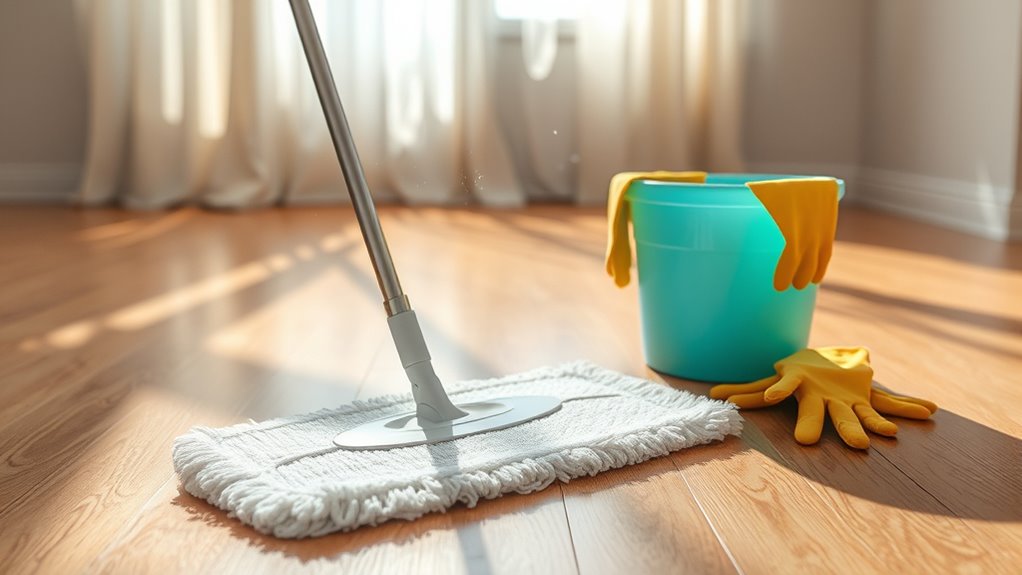
When you want to deep clean laminate floors without causing damage, it is crucial to use the right techniques and products that protect the surface’s finish. Avoid excessive water and harsh chemicals; instead, opt for gentle cleaning solutions designed for laminate maintenance. Use a damp microfiber mop to lift dirt without soaking the floor.
| Fare un passo | Recommended Tool | Key Tip |
|---|---|---|
| Dust & Sweep | Soft broom or vacuum | Remove loose debris first |
| Mop with Cleaning Solution | Mocio in microfibra | Use diluted, laminate-safe cleaner |
| Dry Immediately | Clean, dry cloth | Prevent water seepage |
Removing Tough Stains From Carpeted Floors
If you’re dealing with tough stains on carpeted floors, addressing them promptly and correctly is essential to prevent permanent damage. Effective stain removal requires a targeted approach combined with the right tools and products. Here’s how to tackle those stubborn spots:
Prompt and proper care is key to removing tough carpet stains and preventing lasting damage.
- Blot the stain immediately using a clean cloth to absorb excess liquid without rubbing, which can spread the stain.
- Apply a specialized carpet stain remover following the manufacturer’s instructions for best results.
- Gently agitate the area with a soft brush to lift the stain from the fibers without damaging the carpet.
- After cleaning, use carpet fresheners to neutralize odors and restore your carpet’s natural vibrancy.
Tips for Maintaining Clean Floors After Deep Cleaning
To keep your floors spotless after a deep clean, you’ll want to establish a daily sweeping routine that removes dirt and debris before they cause wear. Using protective floor mats at entryways is essential to trap grime and prevent it from spreading throughout your space. These simple habits will extend the life of your floors and maintain their pristine condition.
Daily Sweeping Routine
A consistent daily sweeping routine plays a crucial role in preserving the results of your deep floor cleaning. By adopting effective sweeping techniques and sticking to a daily schedule, you’ll prevent dirt buildup and maintain pristine floors effortlessly. Here’s how to optimize your routine:
- Use a broom or vacuum suited for your floor type to avoid damage.
- Sweep in a systematic pattern, such as corner-to-center, ensuring no spot is missed.
- Focus on high-traffic areas daily, while less-used spaces can be swept every other day.
- Empty your dustpan or vacuum container immediately to prevent redistributing dirt.
Following these steps guarantees your floors stay clean longer, giving you the freedom to enjoy your space without constant deep cleaning interruptions.
Protective Floor Mats
Three types of protective floor mats can greatly extend the cleanliness of your floors after a deep clean. Entrance mats trap dirt and moisture before it reaches your floors, reducing wear and tear. Anti-fatigue mats, placed in work areas, protect surfaces from scratches and provide comfort. Finally, decorative area rugs shield high-traffic zones while enhancing your space’s style. Understanding floor mat benefits helps you maintain cleanliness effortlessly. When choosing materials, opt for durable, easy-to-clean options like rubber, polypropylene, or natural fibers. Rubber mats excel in moisture resistance, while polypropylene offers stain resistance and durability. Natural fibers provide breathability but require more care. By selecting the right mats for your needs, you guarantee your floors stay pristine longer, granting you freedom from constant maintenance and preserving your deep cleaning efforts.

